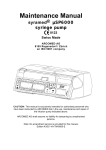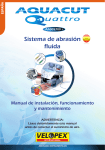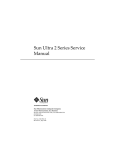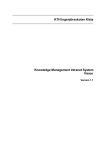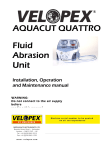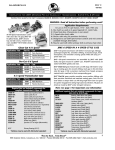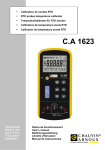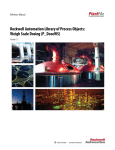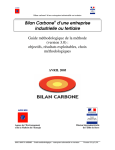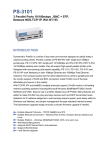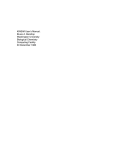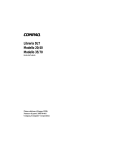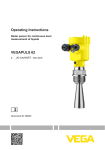Download - Frank`s Hospital Workshop
Transcript
Maintenance Manual Volumed® µVP7000 Swiss Made ON RATE ML/H VOLUME ML 2 MIN START BOLUS OPTION OFF STOP volumed µVP7000 RATE KVO INF COMPL DEFECT ARCOMED AG 8105 Regensdorf / Zürich (an ISO 9001 company) Important This manual is exclusively intended for authorized personnel who have been instructed by Arcomed AG in the maintenance and repair of the Infusion Pump indicated above. Arcomed AG shall assume no liability for tampering by unauthorized persons. Caution: The manufacturer reserves the right to improve the specifications of this product without prior notice. Edition 02/03 -VA-TM-7000-E Contents Page Index numbers 0 1. Introduction 1 1.2.2 Service Intervals 2 2. Specifications 3 3. Operation 4 3.18 Parallel / Multiple Infusions 10 4. Alarm Supervision System 11 5. Warranty 13 Design Changes 13 6. Inspection and Maintenance Intervals 14 7. Significance of Trumpet Curves 15 8. Technical description 17 9. Trouble shooting 21 10. Replacement of parts 22 11. Spare parts list 7000 23 Annex A Drawings Annex B Schematics Annex C Component layout Index Numbers 1 Administration set 2 Drip chamber 3 Stop flow clamp (internal or robson clamp) 4 Empty container detector (ECD) 5 Door 6 Door latch 7 On / OFF key 8 Rate display 9 Volume display 10 Start / Stop key 11 Tube guides 12 Pumping-peristaltic 13 Occlusion detector 14 Stop flow device 15 Air detector 16 Rate keys 17 Volume keys 18 Option key, Alarm tone-mute key 19 Prime / Bolus key 20 Alphanumeric LCD display 21 Alarm window 22 Information window 23 Mains supply socket 24 Fuses 25 Connector nurse call 26 Connector empty container detector (ECD) 27 External power supply (12 DC) 28 Infra red interface 29 Pole clamp 30 Carrying handle 11 4 12 7 11 3 14 1 2 15 11 6 5 7 6 ON 8 16 RATE ML/H 30 6 13 9 18 VOLUME ML 10 19 2 MIN START BOLUS OFF OPTION STOP RATE KVO INF COMPL DEFECT arcomed ag volumed µVP7000 22 20 21 Volumed µVP7000 Front view 29 30 25 23 24 25 26 27 28 Volumed µVP7000 Rear view 1. Introduction 1.0 Introduction The Volumed® µVP7000 Volumetric Infusion Pump has been developed using the latest state-of-the-art technology. This microprocessor-controlled volumetric pump operates by pumping the infusate using a peristaltic system. The sterility of the infusate is not affected. The pump is designed to infuse drugs or other infusates into the patient by controlled means under pressure. The Volumed µVP7000 meets the performance requirements of the MDA (UK) for neonatal and high risk infusions. It can be used in both stationary and transportable applications as it has a battery life up to 6 hours duration. Applications include neonatology, intensive and cardiac care, paediatrics, gynaecology and osbstetrics, surgery and general medicine. It can also be used in ambulances or for laboratory use. For infusions with very small rates and small volumes it is recommended to use a syringe pump such as the Syramed® µSP6000 as the the remaining volume in the administration set can become significant compared to the infused volume. The Volumed µVP7000 meets the Medical Device Directive (MDD) requirements of the EC Guideline 93/42 EEC and is marked CE. Classification: Class IIb The manufacturer according to MDD is Arcomed AG, Althardstrasse 146, CH 8105 Regensdorf, Zurich, Switzerland. Responsible for the EC is Arcomedical Infusion Ltd., West Horndon, Essex CM13 3XS, UK. The Volumed µVP7000 may be operated only on mains power installed to DIN 57107 VDE 0107 or the appropriate national standards. If the integrity of the mains power supply protective earth system is in doubt, the pump should be operated on battery power. Mobile telephones should not be used anywhere near this equipment. 1.1 Mounting the pump Check the pump and accompanying accessories for damage when unpacking. The pump must not be operated if damaged. Should the pump be damaged contact our Service Department. Permitted mounting: positioned on a flat horizontal surface or pole mounted on an infusion stand or rail mounted. The pump should normally be operated from a mains power supply. The internal batteries will automatically operate the pump in the event of a power failure. CAUTION: This pump is not designed for use in areas where there is an explosion hazard. Environmental requirements as per IEC601-1-2 must be observed. Do not operate this pump in an environment with high levels of electromagnetic radiation such as surgical diathermy or mobile telephones. For further information contact the official distributor in your country or the Customer Service Department in Switzerland: Switzerland: a r c o m e d a g, Althardstr. 146, CH-8105 Regensdorf Tel. 0041 (01)840’47’40, Fax. 0041 (01)840’06’49 United Kingdom: Arcomedical Infusion Ltd., 5g West Horndon Industrial Estate, West Horndon, Essex CM13 3X Page 1 Tel. 0044 (1) 277’81’04’32 Fax. 0044 (1) 277’81’19’67 The technical manual and the list of spares and used materials can be requested from Arcomed. 1.2.1 Cleaning and disinfection CAUTION: The pump must be switched off and disconnected from the mains power supply before cleaning and disinfecting. The pump must be kept clean and dry. Remove any spillage immediately. The pump must not be placed in an autoclave. The unit is disinfected by wiping over with a cloth which has been damped slightly with an alcohol-based disinfectant. Take care when cleaning that no liquid enters the inside of the pump case. Wait at least 30 seconds after disinfecting before switching the pump on. Use only disinfectant that are compliant with: - ABS, POM, stainless steel, PVC, aluminum, silicone Please check with your supplier of disinfectant. 1.2.2 Annual safety check Battery power is provided by a nickel metal hydride (NiMH) battery which must be checked annually. Battery condition is checked by connecting the pump to the mains power supply for 15 hours in a switched off condition so that the battery may be fully charged. Disconnect the mains power supply and switch the pump on using battery power. Determine the operating time when the low battery alarm activates. This should be at least 3 hours - if not the battery must be replaced. Repeated charging and discharging may in certain circumstances cause degeneration of the battery (memory effect). Used batteries must be disposed of in an environmentally friendly manner or returned to the manufacturer. Safety checks (see chapter 6) may be performed only by qualified staff. 1.3. Key to symbols The pictograms and symbols shown on the reverse of the pump have the following meanings or functions: CF (cardiac floating) part Nurse Call Empty bag detector 12 VDC ! IPX 1 CAUTION: consult accompanying documents Drip-proof External 12 VDC supply class II double insulated IR Interface RS232 (Infrared Interface) Page 2 2. Specifications CE Mark Classification Software revision Flow rate range (ml/h) Volume range (ml) A23 02 04 07000 01 IIb 1.xx 0.1 - 999.0 ml/h, increments: 0.1 ml/h 0.1 - 9999.9 ml, increments: 0.1 ml Deviation in flow-rate with 8101P series administration set Deviation in flow-rate with 3101P series administration set typ. +/- 3% (Silicone insert) typ. +/- 5% (PVC line) Overinfusion in case of electrical or mechanical defect Keep vein open rate (KVO) Bolus rate, Prime rate Infusion pressure min. Infusion pressure max. 1.5 ml max. Alarm pressure limit Bolus volume after occlusion Time to alarm after occlusion 0 - 999 mbar/mmHg Automatic bolus reduction (see also 3.9) Depending on rate, pressure limit setting and set, see also table below. Air detection Sensitivity ultrasonic typ. 100 µl, adjustable from 50 to 250 µl Cumulated 15 min adjustable from 500 to 5000 µl Battery operation time (1.85Ah) Charging time Supply voltage External power supply (optional) Input power Mains fuse 3 - 5 hrs (dependent on rate and mode) 15 hours/20 hours 230 VAC+10%-15%, 50/60 Hz 12 VDC 9.3 VA T200 mA/IEC127/III/SEV 1064 Type of protection against electric shock Protection against ingress of liquids Leakage current Radio interference Nurse call, potential-free contact switch Degree of protection against electric shock Dimensions Housing Weight Class II IPX 1, drip proof < 40µA CE-Class A 24V/0.2A 3.0 ml/h, adjustable 1000 ml/h, adjustable 60 kPa / 450 mmHg / 0.6 bar 120-250 kPa / 900-1875 mmHg 1.5-2.5 bar (according to IV set) CF (cardiac floating) 245x90x180 mm (WxHxD) ABS plastic, UL listed 2.6 kg (approx.) Page 3 Max. storage period Permitted temperature range (operation/storage) Permitted relative humidity 3 months without charging 15°C - 35°C / 0°C- 40°C Atmospheric pressure Safety certification 500-1000 hPa DIN IEC 601 Part 1 EN55011 Radio interference IEC60601-1-2 Susceptibility IEC60601-2-24 20-90% max. (no vapor deposit) Operating modes Continual, manual bolus, automatic bolus, priming. Labeling of the pump 12 alpha numeric caracters. Configured through IR interface. History Up to 1500 data logs with real time stamps. Read out and printout through IR interface and PC. Time to alarm after occlusion (PVC set), volume of bolus without bolus reduction: Pressure Rate 1.0 bar 500 mbar 100 mbar 1 ml/h >60 min 45 min 8 min 20 ml/h 3.5 min 100 sec 20 sec 100 ml/h 50 sec 25 sec 5 sec 999 ml/h 6 sec 2.5 sec 0.5 sec Bolus 0.9 ml 0.45 ml 0.09 ml Page 4 3. Operation The figures in brackets refer to the illustrations of front and rear views shown in the appendices. CAUTION: Use only approved disposable adiministration sets! (cf. leaflet "Accessories and Consumables") The performance of the pump depends on both pump and administration set. The volumed must only be used with the sets the pump has been calibrated to. The functional safety of the pump cannot be guaranteed if non-approved IV sets are used. The safety of the patient may be compromised as a result. Disposable IV sets are for single-use only. Single-use needles carry an infection hazard and must be disposed of in accordance with local guidelines. The IV-set should be replaced every 24 hours. 3.1. Preparation and loading of the administration set a) If the pump is to be operated on an infusion stand, care must be taken that the pump is not positioned more than 1.4m above the ground to ensure stability. Ideally use an "Arco Luxe" or "Arco Standard" infusion stand. If several pumps are mounted one above the other the maximum permitted height from the floor must be observed and measures taken to prevent instability. The pump may be fixed to the infusion stand by means of the pole clamp (29) on the rear of the unit. b) Slot the drip chamber (2) into the empty container detector (4). Make sure that there are no large ribs or joints in the passage of the empty container detector and that fallen drops are detected by the drop-detector‘s light-barrier. c) Carefully purge the infusion set (1), without allowing any air bubbles to enter, until the drip chamber (2) is 1/4 to 1/3 full. If air has entered, repeat purge-procedure. d) Close the tubing roller clamp. e) Open the pump door (5) by pulling the latch (6). f) Pump with Robson Clamp: Position the Robson clamp (3) on the tubing. In case of a silicon insert tubing, position the Robson clamp just left of the silicone segment. Close the Robson clamp. Hold the tubing with your right hand with your thumb positioned on the Robson clamp. Starting with the left side, insert the IV set into the left tube guide (11). Ensure that the flow direction of the pump from the left to the right is respected and the tubing is in a straight line. Put the Robson clamp with your thumb into the Stop Flow device (14) and insert the remaining tubing onto the right tube guide (11). Pump with internal clamp: Starting with the left side, insert the IV set into the left and right tube guides (11). Ensure that the flow direction of the pump from the left to the right is respected and the tubing is in a straight line. In case of a silicon insert tubing verify the correct position of the silicon insert as shown in the front view of this manual. g) Close the door (5) and push the latch (6) firmly against the pump. Open the tubing roller clamp. Page 5 h) Switch the pump on: Press ON/OFF key ( ) (10). The audible alarm beeps once together with the indication < ! > in the alarm window (21). The software version number (µVP7000, rx.xx) and the configuration of the pump (µVP7000, c.xxx) light up briefly. Wait until the automatic Stop Flow test is terminated. i) Check if there is no free flow. Where possible mains power should be used. Plug the mains power cable into the connector socket (18) at the rear of the pump. The mains pictogram illuminates as soon as the mains supply is connected. The battery is charged automatically. j) The Volumed µVP7000 has the possibility to prime the line with the pump. Make sure the patient is always disconnected when priming: Press the bolus key (19) until the LCD display (20) shows: priming? Press and hold the bolus key until the priming is finished. To terminate the piming mode press the Start/Stop key (10). Important: during priming both air alarm and empty bag alarm are ignored. The prime rate is displayed in the rate window (8). k) Connect set to the patient. Important: Before the door is opened, close the roller clamp! 3.2. Setting rate (ml/h) and volume (ml) Use the UP/DOWN keys (16) to select the required rate in ml/h indicated in the RATE display (8). Arrow up keys provide rate increase, arrow down keys provide rate decrease. Check that each key stroke changes one digit. The least significant digit (small size) indicates 0.1 (units). If a specific volume (VTBI) is to be infused, the required volume in mls may be selected in the VOLUME window (10) using the UP/DOWN keys (13) before starting the pump (optional). Once the VTBI is reached, the pump gives and audible alarm and displays <INF COMPL> (infusion complete) in the Alarm window (21). The pump switches to the KVO rate. Remark: With the empty bag detector (4) the pump stops automatically after the last drop in the bag. If no empty bag detector is used, the volume (VTBI) has to be set to stop before the bag is completely emptied. Otherwise the pump the pump continues infusing until air is detected in the air detector (18). Hence, it is strongly recommended to use the empty bag detector. 3.3. Pump running When the pump is running, the green drop symbol flashes (22). The VOLUME display now indicates the volume infused in mls. In order to display various data, such as pump condition, volume to be infused, infusion time, time to end of infusion, battery condition, pressure and pressure limit, press the OPTION key (18) sequentially and observe the LCD window (20) until the required data is displayed. If a specific volume to be infused was selected the pump automatically switches to KVO operation when this volume has been infused and an audible and visual alarm (21) activates. Press the ALARM SILENCE key (5) to silence the audible alarm for 2 minutes. Page 6 3.4. Resetting the volume infused In order to reset the volume infused, stop the pump by pressing the STOP key (10). Press the OPTION key (18) for 2 seconds until the VOLUME display (9) flashes. When the LCD window (20) displays "000", confirm this by pressing the START/STOP key (10) to reset the volume infused to zero. If it is not desired to reset the volume infused, press the OPTION key (18) until the normal display appears. 3.5. Infusing a bolus When the pump is infusing, a manual or an automatic bolus can be given. To infuse a manual bolus: Press the OPTION key (18) and the BOLUS key (19) together. The bolus rate is displayed in the RATE window (8) and the bolus volume infused is displayed in the VOLUME window (9). The LCD window (20) indicates "Bolus manual". Keep the keys depressed until the required bolus volume has been infused. As soon as the keys are released the pump reverts to the normal infusion mode. To infuse an automatic bolus: Press the Bolus key (19) for 2 seconds until the display in the VOLUME window (9) flashes. The desired bolus volume in mls can then be preset in the VOLUME display using the VOLUME keys (13). Press the BOLUS key (19) to deliver the bolus automatically. If no bolus is required, press the OPTION key (18) to cancel. During automatic bolus delivery, the RATE display (8) indicates the bolus rate and the VOLUME display (9) indicates the bolus volume infused. The LCD window (20) indicates "Bolus automatic". To stop the pump at any time press the STOP key (10). After the selected bolus volume has been delivered, the pump switches automatically to normal delivery mode. Following bolus infusion, the bolus volume is added to the total ml infused. 3.6. IV container exchange When changing the plastic container or bottle, infusion can be interrupted at any time by means of the 'Start/Stop' key (18) without affecting the set or displayed values. In this state, handling operations such as changing the container or IV set and rate changes can be implemented without activating the alarm. In the stop mode, 'KVO' operation is automatically activated. If the pump remains in the stop mode for more than 4 minutes, the audible reminder alarm will sound. 3.7. Recall of previous data If the pump has been accidentally switched off, data such as rate, volume to be infused and volume infused may be recalled during start up. Press the START/STOP key (10) and the ON/OFF key (7) together to recall all data. 3.8. Setting volume and time If a specific volume is to be infused in a given time the RATE display must be left at zero. After inserting the IV set, closing the door and finishing the automatic test press and hold the OPTION key (18) until the RATE and VOLUME displays flash. Page 7 The time in hours and minutes may be selected in the RATE display (9) and the volume selected in the VOLUME display (9). The pump automatically calculates the infusion rate. Check this carefully in the LCD window (20) before starting the infusion. 3.9. Pressure system The Volumed µVP7000 has automatic pressure monitoring whereby the pressure in the system is measured via the pressure transducer. The alarm pressure limit can be set automatically or manually. Automatic setting: If the pump is configured for this mode, the alarm pressure limit is automatically matched to the set rate, the lower the rate, the lower the alarm pressure limit. The time to alarm can be viewed in the table of section 2. Manual setting: Press the OPTION key (18) sequentially to display pressure and alarm pressure limit in the LCD window (20). Hold down the OPTION key (18) until the VOLUME display (9) flashes "Lxxx". The pressure limit may be manually set using the VOLUME keys (17) in the VOLUME display (9) and the data in the LCD window changes accordingly. This can also be done while the infusion is in progress. NOTE: Manual setting of pressure deactivates the automatic pressure setting, i.e. the pressure remains at the current level independent of the rate selected. If the pressure rises beyond the limit set, the pump stops and the stored bolus is automatically reduced to virtually zero volume. An audible and visual alarm is activated. Check the IV carefully for the cause of the alarm. Do not restart the pump until the occlusion is released. 3.10. Setting time and date Press the OPTION key (18) sequentially to display date and time in the LCD window (20). Hold the OPTION key (18) down until the display flashes. The time may be set using the volume keys (17) in the Volume display (9), e.g. h9.45 = 9:45 am. This can also be done while the infusion is in progress. The Volumed has the possibility to automatically adjust the daylight save time (summer time). The adjustments can be done as per EU, US or Australian regulations. If the text ‘Clock !’ should appear, replace the Lithium backup battery on the main PCB. To set the date, first switch the pump off. Press the VOLUME 0.1 ml DOWN and VOLUME 100 ml DOWN keys (17) together whilst switching the pump on. This enables the Service Mode. Select the RATE display (8) according to the following table using the RATE keys (16). Then select the corresponding data in the VOLUME display (9) using the VOLUME keys (17). Press the START key (10) each time to confirm each setting: Rate display (9) 145 144 143 142 Volume display (10) 0 - 99 1 - 12 1 - 31 1-7 Function Year Month Date Weekday (Monday = 1, Sunday = 7) Press the ON/OFF key (7) to switch the pump off. Page 8 Note: Incorrect setting of date or time does not affect the correct functioning of the pump. 3.11. Different configurations If a different configuration is required, please contact our Customer Service Department or the official ARCOMED distributor in your country. 3.12. Accessories and consumables Accessories, expendable parts and single-use items may only be used if they comply with the appropriate international standard and national approvals. Sets, filters and extension sets must be CE marked. The ordering numbers can be found on the leaflet "Accessories and Consumables" The Instructions for Use, the mains power supply cable and the empty bag detector (optional) are included as standard equipment with the Volumed µVP7000. For accessories see also 3.19. 3.13. START/STOP key (10) The START/STOP key (10) is used to start the pump after the rate has been selected. The pump may be stopped at any time using this key. An additional function of this key is to confirm various parameters. 3.14. Prime / Bolus key (19) The PRIME/BOLUS key (19) key is used to prime the extension set. It is also used to initiate a manual or automatic bolus (3.5). 3.15. AUDIBLE ALARM SILENCE/ OPTION key (18) The audible alarm may be silenced for 2 minutes using the ALARM SILENCE/OPTION key (18). The audible alarm is re-activated after this period. If there is no audible alarm, the key serves as an OPTION key which enables selection of any option. 3.16. ON/OFF key (7) The pump may be switched off using the ON/OFF key (7) if the infusion has been completed. All data displayed (rate and volume) is lost when the pump is switched off. In order to avoid switching the pump off accidentally, the ON/OFF key (7) must be pressed for at least one second before the pump switches off. If the pump is connected to the mains, the STANDBY mode will switch in when the pump is switched off. This means that the battery will be charged and the charge condition indicated in the LCD window. 3.17. Keep-Vein-Open (KVO) - Rate The pump may be configured to infuse at the keep vein open rate when the volume to be infused has been delivered. The KVO rate is preset at 3.0 ml/h and may be set (by a technician) to suite individual requirements if necessary. If the set rate is smaller than than the KVO rate, this rate becomes the KVO rate. Remark: The latest standard uses the new wording Keep-Open-Rate (KOR). The meaning is identical to the KVO-rate. Page 9 3.18. Using the pump in parallel or multiple infusions If additional infusion systems are connected to the patient's vascular system, this may lead to complications e.g. infusion of air, reverse-flow, interruptions due to alarms and inaccurate flow. To prevent such incidents, please observe the recommendations as stipulated in DIN VDE 0753, Part 5 or contact your distributor. 3.19. Options for external connection to the pump External equipment may only be connected to the Nurse call connector (25), empty bag detector (26) and external supply (27) if the system which results from this meets the requirements of standard EN60601-1-1 and if their safety has been certified by an approved international body. - Use cable number 94070 to connect the Nurse call system. Important: The alarms on the pump have to be observed also when the nurse call is connected. - If an external 12 VDC power supply is used and is linked to other equipment, ensure that the safety of the system complies with IEC60601-1. Use cable number 71630. - Use only the external empty conntainer detector Nr. 98502 (4) Please contact the Customer Service Department of ARCOMED AG for details of the RS232 interface (IR interface) and how to link it to external systems. Page 10 4. Alarm system 4.1. Alarm causes The electronic self-monitoring system continuously monitors the correct functioning of the pump and its displays whilst in operation. If a fault should occur, the infusion is stopped immediately and the alarm activates. The corresponding alarm symbol is illuminated continuously with a red colour and there is a continuous audible alarm. The nurse call alarm is activated at the same time. The pump will not start: - if no rate has been set (0 ml/h). - if air is in the line - if the door is open. - if the IV set or the Robson clamp is not correctly installed. During operation an audible alarm activates and the pump switches to the KVO rate if: - the START/STOP key is operated. - the VTBI is reached - attempts are made to alter the rate during operation. During operation an audible alarm activates and the pump stops if: - the roller clamp is not opened. - the bag is empty. - battery capacity is low and the charge can no longer ensure controlled infusion. - the infusion pressure exceeds the limit set. - the door is opened. - there is an internal defect. With empty bag detector: - if the detected drops do not correspond with the set tolerances. - if the level in the drip chamber is too high. 4.2. Canceling the alarm condition After rectifying the cause of the alarm or acknowledging the rate change, the alarm condition is canceled and infusion resumed by pressing the START/STOP - key (10). 4.3. Pressure limit/occlusion alarm If the pressure in the system reaches the set pressure limit due either to a total or partial occlusion, the alarm activates and the occlusion alarm symbol and rate display flash. The LCD window displays "occlusion! check line!" The vein site should be checked to ensure there is no complication. If the cause of the occlusion is removed, the occlusion symbol flashes and the pump may be started again. Page 11 4.3. Battery alarm The pump may be operated independently of the mains power supply using the internal battery. If the mains power supply fails, the pump switches automatically to battery operation to continue the infusion without interruption. Battery operation is indicated by illumination of the battery symbol (22). Battery capacity permits from 3 up to 6 hours operation (1.85 Ah battery) depending on the infusion rate set. After approximately 3 to 6 hours operation the battery symbol in the alarm display (21) illuminates and an audible alarm activates. Alarms are canceled automatically as soon as mains power is restored. A low battery alert is activated approximately 30 minutes before the battery depleted alarm. The battery symbol (21) flashes and an audible alarm activates. To silence the audible alarm, press the ALARM SILENCE key (18). The battery symbol continues to flash until the pump is reconnected to the mains. A cautionary alarm is activated if the pump is disconnected from the mains power supply whilst in operation. This alarm may be silenced using the ALARM SILENCE key (5). 4.4. Nurse call The pump may be connected to the external nurse call system via the connector (25) on the rear of the unit using cable part number 94070. All alarms are transmitted to the nurse call station. The normal pump alarms and displays continue to function. 4.5. Alarm silence Audible alarms may be silenced for approximately 2 minutes using the ALARM/SILENCE key (18). The audible alarm is reactivated after this period. 4.6. Alarm indicators (18) The cause of the alarms are indicated using illuminated pictograms as shown: KVO keep vein open rate RATE Rate changed 4.7. KVO Occlusion alarm Empty bag alarm INF COMPL Defect DEFECT Infusion complete Air alarm Power and running indicators (22) These are indicated by the following: Pump running Mains operation Battery operation Page 12 Battery alarm 4.8. LCD window (20) Various messages and infusion parameters are displayed in this window. 4.9. Technical description The Volumed µVP7000 is a microprocessor-controlled infusion pump with stepper motor drive and comprehensive software management function monitoring. The pump is operating range enables infusion rates from 0.1 ml/h to 1, 999 ml/h to be made. An internal rechargeable battery allows the unit to operate independently of the mains in emergencies or when used as a mobile unit. The mechanism is driven by a step motor via a toothed belt and friction spindle. All important operating parameters are clearly shown on an LED indicator. Setting the desired values is done via touch-pad keys. The unit is manufactured using the latest surface mounted control technology (SMD). 5. Warranty Arcomed AG offers a twelve month warranty on each Volumed µVP7000 volumetric pump effective from date of delivery. The warranty covers the installation and replacement of faulty parts if caused by faulty assembly or materials. The warranty is rendered null and void if changes or repairs are carried out by persons who have not been authorized in writing to do so by Arcomed AG or Arcomedical Infusion Ltd and if the inspection and maintenance intervals are not observed. The warranty does not cover the elimination of problems caused by incorrect operation, inappropriate handling or normal wear and tear, The supplier only accepts responsibility for the safety, functional reliability and performance of the equipment providing that - assembly, extension work, resetting, modification or installations are carried out by personnel authorized by him. - the electrical system at the operating site meets IEC requirements. - the unit is used in accordance with these Instructions for Use. The information provided in this manual applies to the currently prevailing situation and is given in good faith. The manufacturer reserves the right to make modifications in the interest of technical progress. 5.1. Design changes Arcomed AG endeavour to ensure that future improvements and modifications are compatible with earlier models. NOTE: Always state the model, serial number and where applicable the colour of the unit in question when ordering spares. Page 13 6. Inspection and maintenance intervals Volumetric Infusionpump Volumed ® µVP7000 (according MDD) Interval: After 24 m months or 10’000 h of use. The following checks must be done by an engineer with sufficient technical background to comply with the safety regulations. What to do How / Equipment Remarks Result Visual Check Housing External emty container detector (ECD) (Easy Clip) or Internal empty container detector (ECD) ( especially spring ) Door, door latch Stop-flow lever Cover for peristaltic blades Inscriptions, display Display - LED Mains plug, fuses Air in line Physical damage Physical damage Physical damage Clean, function Clean, function Physical damage Readable, damage Function, display test Damaged, values Physical damage Functional checks o Spring plate manual o Pressure checks: IV-set filled with water, manometer & tubing o minimal mechanical pressure: preload system with syringe to 0.7 bar 4 min. at rate 5 ml/h (press. limit 999 mbar) watch manometer pressure always above 0.6 bar p min = rate 400 ml/h (press. limit 999 mbar) pressure always below 2.5 bar* p max = o Pressure Sensor: rate 100 ml/h pressure limit 500 mbar make occlusion on set alarm reaction within 20 sec ±10 sec o Rate check: Rate 100 ml/h Total of 100 ml ± 5 % accuracy* Refer to trumpet curve (tech manual) Take out drop chamber of ECD detector Visual and acoustic alarm o simulate Air in Line Air bubble (eg reverse drip chamber) in the line Visual and acoustic alarm o check nurse call e. g. open door while pump is running alarms and switching signal at connecter o (External pump stop only Option RS 232C) Electrical safety according to IEC 601 o Leakage current o Resistance protective conductor Safety Tester IEC 601 ≤ 75µA ≤ 100 mOhm o maximal mechanical pressure: while running on 100 ml/h o simulate missing drops check free motion o alternative test PTD-7000 o alternative test VT-5000 % dev = IEC 601.1, section 19 The rates of the fuses must comply with the rates recommended by arcomed (producer): Conventional transformer 230V :100 mAT/250V, toroid transformer 230V: 250 mAT/250V, toroid transformer 115V: 500mA T/250V ( IEC127/III/SEV 1064). Caution: After any work on the pump (e. g. adjustment of programming, change of parts, any opening of the pump) this inspection must be made and all checks must be documented with the serial number of the pump. * depending on set (eg. 3101P PVC 2.5 bar, ± 5%, 8101P Silicone 1.5 bar, ±3%). Serial Number: Remarks: Page 14 Date /Signature: 7. Perfomance 7.1 Significance of trumpet curves for practical use Trumpet curves indicate for 5 different observation windows the maximum and minimum mean values of the flow rate in ratio to the preset flow rate. Known therefore is the discrepancy per time-window. For optimal use of the infusion pump Volumed® µVP7000, the trumpet curve is an important factor in deciding whether the pump can be used with the prescribed drug. Volatile drugs with short therapheutic half life demand high accuracy. For a drug where the plasma-half life is e.g. 1 min. discrepancy of the flow rate of 15% per minute would mean the same discrepancy for the plasma level. Therefore, a predictable constant impact of the drug would not be guaranteed. Example: Intraveinous infused Insulin has a therapheutic half life of 15 minutes. A flow deviation of ± 15% within 40 minutes would have at least the same (rather twice as much) influence on deviation of the plasma level and therefore on its impact. This is inacceptable to physicians and nursing personel. It is important to know that the deviation in a short observation window depends strongly on the preset rate. The Volumed® µVP7000 has at a rate of 25 ml/h a deviation smaller than ±2% in a observation window of 2 minutes.With 5 ml/h the deviation in the same observation window is ± 7%, within 5 minutes it is ±3%. Mean deviations are within ±5% (see also following table). Table 1: Flow Accuracy of the Volumed® µVP7000 (typical values) Rate (ml/h) 2 min Max 5.0 25.0 100.0 Rate (ml/h) 5.0 25.0 100.0 +6.93% +4.54% +0.60% eff. Rate (ml/h) 5.010 24.800 101.182 Min Max -5.99% -3.65% -1.17% 5 min Min +3.08% -3.45% +1.39% -1.46% +0.28% -0.76% Abweichung Stand.-Abweichung Testzeit Messzeit (%) (ml/h) (h.min) (h.min) 0.203 -0.399 1.182 0.010 0.200 1.182 Page 15 2.00 2.00 2.00 1.00 1.00 1.00 File Name: 25ml/h IEC 7000 ø Flow (2nd h): ø Error[%] (2nd h): 25.788 3.153 Rec. date: Rec. time: Rate (ml/h): 11.2.2002 10:54:24 Uhr Evaporation: 25.0 0.00 # Scans: Interval (s): 240 30 Flow [ml/h]: 50.0 37.5 25.0 12.5 0.0 0:00 0:10 0:20 0:30 0:40 0:50 1:00 1:10 1:20 1:30 Trumpet Curve (2nd h): 1:50 2:00 2 Min (max): 2 Min (min): 10.0 4.54 -3.65 5 Min (max): 5 Min (min): 5.0 1.39 -1.46 11 Min (max): 11 Min (min): 0.0 0.60 -0.88 19 Min (max): 19 Min (min): -5.0 -10.0 0:00 1:40 0.57 -0.37 31 Min (max): 31 Min (min): 0:10 0:20 0:30 0.28 -0.33 File Name: 5ml/h IEC 7000 ø Flow (2nd h): ø Error[%] (2nd h): 5.010 0.203 Rec. date: Rec. time: Rate (ml/h): 19.2.2002 10:07:52 Uhr Evaporation: 5.0 0.00 # Scans: Interval (s): 240 30 Flow [ml/h]: 10.0 7.5 5.0 2.5 0.0 0:00 0:10 0:20 0:30 0:40 0:50 1:00 1:10 1:20 1:30 Trumpet Curve (2nd h): 1:50 2:00 2 Min (max): 2 Min (min): 10.0 6.93 -5.99 5 Min (max): 5 Min (min): 5.0 3.08 -3.45 11 Min (max): 11 Min (min): 0.0 1.77 -0.91 19 Min (max): 19 Min (min): -5.0 -10.0 0:00 1:40 1.23 -0.52 31 Min (max): 31 Min (min): 0:10 0:20 0:30 0.71 -0.14 8. TECHNICAL DESCRIPTION 8.1 Introduction The microprocessor controlled peristaltic pump Volumed® µVP7000 is supplied with a step motor drive and comprehensive software monitoring. The operating range of the pump allows rates from 0.1 - 999ml/h to be selected. An integrated, rechargeable battery permits mains-independent operation for emergencies or for ambulatory use. A stop flow device is installed behind the door to prevent the infusion solution from flowing freely in the event of the pump door being opened inadvertently. The peristaltic system is driven by a step motor via a positive-engagement toothed belt, with the individual blade movements being controlled by an eccentric camshaft. These blades are fully protected by a rubber cover. All important operating parameters are clearly reproduced on an LED display. The desired values are entered via a keypad. All important operating parameters are clearly shown on two LED displays with an additional LCD for messages and various other data. Infusion parameters are set via touch keys which comprise a mechanical switch covered by a sealed membrane. The unit is manufactured using the latest surface mount technology (SMT). In the circuit description that follows, reference is made to diagrams 1 to 3. 8.2. Circuit description 8.2.1. Microcontroller Microcontroller D0 monitors the following signals: Motor controller The step motor drive D8 is controlled directly by the microcontroller and operates in chopper mode. The step motor operates in micro-steps to provide continuous and smooth delivery even at low flow rates. Main shaft revolution pulses A Hall sensor adjacent to the main shaft produces a pulse for each revolution of the shaft. In the microcontroller this is monitored by software on a frequency/time basis. Watchdog The external Watchdog in IC D2 monitors program run time. If the limits are not within the specified time, the semi-conductor relay VO interrupts power to the step motor. A fault is signaled to the microcontroller via the inverter D7. The relay D10 is periodically switched off for a short period to test the watchdog and the correct functioning of the microcontroller is monitored. There is a second watchdog in the microcontroller. Page 17 Operating voltages The supply voltage, the 5V logic supply rail and reference voltage are measured and monitored via disc resistors by the analog/digital converter in the microcontroller. Mains/battery operation The level of the operating voltage determines whether mains or battery operation is used. Battery voltage The battery alarm activates if the minimum operating voltage falls below the set limits during battery operation. The unit will be shut down in the case of exhaustive voltage discharge. Logic rail voltage The rail voltage is limited to a maximum of 5.5V by diode V20, and transistor V5 triggers the microcontroller and external Watchdog if 5.8V is exceeded. If the level reached is less than 4.5V, the integrated circuit D2 initialises the system. Microcontroller D1 controls the following signals: Step motor pulses The step motor pulses are fed by the microcontroller from the quartz oscillator at a frequency corresponding to the rate set. Watchdog Watchdog D2 is triggered periodically after each program run. Buzzer (audible alarm) Dependent on the operating status the microcontroller activates the audible alarm trigger K1 via driver V9. Alarm relay Dependent on the operating status the microcontroller activates the alarm relay KO (Nurse call) via driver V8. On/Off function After start up the microcontroller triggers a hold of the semi-conductor relay V12 via the Power-Hold line. The supply voltage remains switched on. When operating the ON/OFF key or if the battery is discharged the microcontroller turns the supply voltage off via the semiconductor relay V12. A/D converter The microcontroller controls the internal A/D converter and measures the results. Page 18 Infra red interface The microcontroller sends and receives data via IC's D10 to D12. The encoder D10 converts the signals to Standard IrDA 1.0. The unit can receive and transmit data from above (D11), below and to the rear (D12). This provides a wire-less connection between units mounted on top of each other. EEPROM memory Set values and important data are held in non-volatile memory D3 and/or recalled from there and remain available even when the pump is switched off. Even when the battery is fully discharged data is not lost. SRAM memory and real time clock IC D2 is an external SRAM and provides storage of a multitude of data. Simultaneously time and date can be read from the real time clock. The real time clock is buffered by a special battery and can work independently for up to 10 years even when the battery is fully discharged. The clock is only an indicator. An incorrrect date or time will not effect the normal functioning of the pump. 8.2.2. Display The operating status is depicted by the LED displays and illuminated pictograms. Display drivers M2, M3 and M4 are controlled by the peripheral IC's D3 and M1 and multiplexed by the microcontroller. Rate Volume Alarm pictograms Pump infusing Battery operation Mains operation 4-digit red numerals 5-digit red numerals red LEDs green LED green LED green LED 8.2.3. Inputting infusion parameters All data inputs are made via keys which are periodically checked by the microcontroller. Only the ON/OFF key is connected separately and controls the start-up logic or releases a delayed shut-down via the microcontroller. The keys have the following functions: Function: Key: Start -up/Switch off pump Rate setting ON/OFF Rate 100 ml/h up/down Rate 10 ml/h up/down Rate 1 ml/h up/down Rate 0.1 ml/h up/down Volume setting Volume 1000ml up/down-Volume 0.1 ml up/down Start/Stop START/STOP pump Prime/Bolus Prime/Bolus key Alarm silence/Option 2 MIN, Option (In an emergency the audible alarm is silenced for 2 minutes) Page 19 8.2.4. Power supply Mains power is supplied via a toroidal transformer and the rectifier V10. In the event of a mains power supply failure, power is supplied without interruption by the internal battery. The charge switch V14 ensures the battery is constantly charged when the unit is connected to the mains (even when the unit is switched off). Relay V12 switches the supply voltage on or off. On the one hand this function is controlled by the ON/OFF key and by a command from the microcontroller via the inverter D7. On the other hand the microcontroller can in the same way trigger the shut down of the supply voltage. The circuit controller D13 produces the +5V rail voltage. 8.2.5. Monitoring Microcontroller: On start up the registers are checked for initial status and a RAM test performed. Air bubbles: 50 µl detection limit, integration over 15 min., individual bubbles > 50 - 250µl adjustable Cumulative air alarm over 15 min adjustable 500-5000µl every 120 ms. Air detector test: Pressure: Contious monitoring of pressure in the line in mbar or mmHg. Pressure limit 1…999 mbar/mmHg settable. Empty bag detector: (Option) Alarm after 330 µl no drops Alarm after 660 µl if < 5 drops Alarm after 660 µl if ≥ 22 drops (adjustable) Pump camshaft: One revolution of the pump camshaft requires 246 step motor pulses. For each complete revolution of the pump camshaft, the hall pulse initiates a comparison with the number of step motor pulses supplied. Tolerance per revolution +/- 20% pulses. Functional check every 62 msec. A key actuated for more than 60 seconds triggers a fault signal. On start up the registers are checked for initial status and a RAM test performed. Continuous ROM, RAM and CPU test during delivery. External watchdog monitors programme run time; approx. ±15%. Microprocessor monitors the following voltages: - mains/battery changeover threshold: 15V - Battery charged: 11V Semiconductor relay: Keypad: Microcontroller: Program run time: tolerance Operating voltage: Page 20 9. Audible alarm repeat: - Battery discharged: 9V - 5V rail monitoring < 4.5V: fault signal > 5.8V: fault signal - A/D converter: defect >2.5%: fault signal On 0.6 sec Off 3.0 sec Other functions: - Audible alarm in standby mode Trouble shooting When a DEFECT signal is given a fault code is displayed automatically. In the Volume ML (12) window a 2-digit figure appears and the cause of the fault indicated is listed in the table that follows. When a fault occurs the code appears automatically as F-xx. Code (Volume ML) Meaning: Measure: 0 2 3 4 5 6 7 8 9 10 11 12 13 14 15 16 17 18 19 >20 Replace main PCB Replace main PCB Check drive Replace main PCB Check stop flow driver Replace main PCB Replace display PCB Replace main PCB / Lithium battery Replace EPROM Replace main PCB Check all EEPROM values Replace main PCB / Lithium battery Replace main PCB Replace main PCB Replace main PCB Replace main PCB Replace main PCB Replace main PCB Replace main PCB Check pump / replace main PCB Program sequence Step motor too fast Step motor too slow AD converter fault Stop flow clamp fault Supply voltage Key blocked Watchdog Test CRC Test EPROM Run time CRC Test EEPROM Watchdog test 1 Initial CPU test Register test SRAM test Bit-walk Test RAM CPU Test (Instruction set) Stop flow (battery) Stop flow (mains) combined errors Page 21 10. Replacement of parts The Volumed symbol µVP7000 may only be repaired by ARCOMED AG or persons officially authorised in writing by Arcomed AG or Arcomedical Infusion Ltd to do so. In the event of a warranty claim please send the unit to the address shown in Chapter 1.1. CAUTION: The unit must be switched off and the mains connection removed before commencing repairs. a) Dissassembly of case: Remove the two tie screws in the pole clamp on the rear of the unit and separate the two sections of the case. First check and record the positions of all connectors and the disconnect those between the front and rear assemblies where necessary. Ensure that all connectors are correctly positioned and inserted when reassembling the unit (see Topography Main PCB). b) Removal of the main PCB: Undo the four screws between the main PCB and the chassis. CAUTION: Sensitive electronic parts can be damaged by static voltage if the main PCB is handled incorrectly. Be sure that correct cable connections are made when reassembling unit (refer to socket positions on the leaflet Main PCB Topography). The connector PCB is also fixed by two screws. c) Removal of the display PCB and covers: Undo the eight screws at the rear of the door which hold the door assembly together. Undo the five screws between the PCB and the front door section and carefully remove the PCB. After reassembly ensure the correct key functioning. d) Removal of the mecanical assembly (drive): After removal of the main PCB undo the mounting screws and spacers holding the mechanical assembly to the case. Carefully withdraw the whole drive and disconnect the hall cable. The mechanism can then be removed from the case. Re-assemble in reverse order. Check that the cabels are connected firmly (front print, hall sensor, pressure sensor) and the DC motor cable is fed through the opening in the side plates. When assembling the main pcb, check the stepper motor cable to be in the corresponding space. Page 22 11. Volumed µVP7000: List of spare parts Please quote the serial number of the pump when ordering. Part no. Description 70000 70010 70020 70030 70050 70070 70080 70100 70110 70120 70131 70140 70160 70170 70180 70200 70270 70280 70320 70370 70470 70490 70550 70570 70585 70770 70800 70810 70830 70860 70901 70911 70920 70940 70960 71160 71170 71180 71210 71230 71240 71250 71260 71271 71690 71700 75000 75010 75020 75030 75040 75050 75060 Assy Rev. Case rear Back 1 BC00 8mm safety ring Back 1, Front 1 BC00 Rubber foot - blue Back 1, Front1 BC00 Screw M3/10 Back 5 BC00 Nut M3 Door 2 BC00 Mains connector Back 5 BC00 Plastic screw 3 x 10 Back 3, Front 5 BC00 Fuse T200mAT/250V Back 5 BC00 IR window Back 6 BC00 Cylinder screw M4x6 Back 4 BC00 Toriodal transformer 9.3VA 230V Back 4 BC00 Toriodal transformer 8.5VA/110V Back 4 BC00 Tie 6000 Back 7 BC00 Handle 6000 Back 7 BC00 Bolt 4x20 Back 7 BC00 Ferrite Transformer Back 4 BC00 Mask LED Door 3 BC00 Foil 1 x 3 LED Drive9/Door3 BC00 Plastic screw 2.5 x 6 Door 2, Door 6 BC00 Plastic screw 2.5 x 16 Door 7 BC00 Drive pully 13MXL complete Drive BC00 Cylinder screw M3x8 Front 9, Front 10 BC00 Magnet ø3 x 3 Drive 12 BC00 Drive pully 32MXL complete Drive 12 BC00 Pulley No 5 Drive, StopFlow 00 Plastic screw 2.2 x 8 Drive 6, Front 3 BC00 Gear weel Drive 10 BC00 3m nurse call cable final BC00 Ferrite Nurse Call Final BC00 Micro fuse T1A battery final BC00 EPROM M 27 C 512 Front BC 25 Main PCB 6000/ 4 BC 25 (extended Eprom 512) Front BC25 O-ring tie Back BC00 Spacer M3x40 Front 2 BC00 Door rod Front 2 BC00 Battery 9.6V/1.85Ah Front 9 BC00 Battery holder Front 9 BC00 Mounting plate back Front 9 BC00 Lithium battery time keeper DA mit Hauptprint BC00 Labels ø8mm final BC00 Screw M3/10 Back 5 BC05 Cylinder screw M3x4 Back 5 BC05 Screw M3x4 Back 5 BC05 Seal mains cable Back 5 BC55 Backlight Displayprint BC00 LCD Display Displayprint BC00 Case front Front BC00 Door external part Door BC00 Door internal part Door BC00 Lever left and right Door BC00 Bearing plate Front BC00 Plate air in line detector Front, Door BC00 Plate pressure sensor Front BC00 Page 23 Material ABS steel Santoprene steel steel plastic UL94V-0 steel glass/steel polyamide steel ABS / copper ABS/Cu aluminium steel steel ferrite ABS PVC steel steel POM steel magnet POM POM steel steel cable ferrite electronics electronics electronics Santoprene steel steel NiMH steel steel Litium PVC steel steel steel steal, rubber electronics electronics ABS POM POM POM POM POM POM 75070 75080 75090 75100 75110 75120 75130 75140 75150 75160 75170 75180 75200 75210 75220 75230 75240 75250 75260 75270 75280 75290 75300 75310 75320 75350 75360 75370 75380 75390 75400 75410 75420 75430 75440 75450 75460 75470 75480 75490 75500 75510 75520 75530 75540 75550 75560 75565 75570 75580 75590 75600 75610 75620 75630 75650 75660 75670 75680 Apdapter PVC 7000 Case Stop Flow Stop Flow Adapter Stop Flow Adapter standard Actuator Stop Flow Side Plate 7000 Slider 7000 Back plate 7000 Mounting plate 7000 Frontpanel 7000 Transformer mounting plate Camshaft 7000 Door support Chassis pump bloc 7000 Door hinge (right) Door hinge (left) Clutch 7000 Motor connection 7000 Joint cable 7000 Spacer M3 x 50 Insert thread M2 x 3 Screw M1.6 x 8 Screw M2 x 12 Screw M2 x 8 Screw M2 x 4 Ball bearing ø10/ø3 x 4 Screw PT 4 x 25 Screw PT 4 x 30 Washer M3/3.2/9/1 Screw M3 x 10 Spacer tube 4*0.4*4 Spacer tube 4*0.4*5 Spacer tube 4*0.4*6 Hall pcb complete 7000 Bolt 1.5 x 10 Screw for plastics 2.5 x 12 Screw for plastics 2.5 x 10 Screw for plastics 2.2 x 4.5 Foil 1 x 1 LED Display pcb 7000 Connector PCB 12V 7000 Front PCB 7000 Pressure sensor 7000 Spacer M3 x 8 Screw M3x12 Bolt 4 x 16 Stepper Motor 7000 Stepper motor 7000 DC Motor 7000 Motor belt 40 MXL 7000 Motor support 7000 Spindle for door 7000 Main PCB 7000 Clutch complete 7000 Tube seal Sticker Front view µVP7000 Sticker Condensed instr. µVP7000-D Sticker Condensed instr. µVP7000-F Sticker Condensed instr. µVP7000-E Front StopFlow StopFlow StopFlow StopFlow pump bloc pump bloc pump bloc Back 2, StopFlow Door Back 4 pump bloc Door pump bloc Front Front pump bloc pump bloc door Front StopFlow StopFlow StopFlow StopFlow StopFlow pump bloc pump bloc pump bloc pump bloc pump bloc pump bloc pump bloc pump bloc pump bloc Door door Door, Front Door, Front Door3 Door Back Front p sensor Front Front Front Pump bloc Pump bloc StopFlow Pump bloc pump bloc Door Front BC00 BC00 BC00 BC00 BC00 BC00 BC00 BC00 BC00 BC00 BC00 BC00 BC00 BC00 BC00 BC00 BC00 BC00 BC00 BC00 BC00 BC00 BC00 BC00 BC00 BC00 BC00 BC00 BC00 BC00 BC00 BC00 BC00 BC BC00 BC00 BC00 BC00 BC00 BC00 BC00 BC00 AC105 BC00 BC00 BC00 00 BC00 00 00 BC00 BC00 BC00 BC00 Dichtung Exzenter BC00 Front BC00 final BC00 final BC00 final BC00 Page 24 ABS POM POM POM POM POM POM POM PVS-G PVS-G steel steel steel steel steel steel Brass Brass Rubber steel Brass Iron Iron Iron Iron Steel steel steel steel steel steel steel steel electronics steel steel steel steel PVC electronics electronics electronics electronics steel steel steel iron / copper Iron / cupper iron / copper rubber steel steel electronics Brass/rubber NBR PVC PVC PVC PVC 92201 92461 93980 98100 98275 98435 98635 98641 98643 98780 98932 99290 99360 99565 99730 99810 99820 99950 Pump housing (blade housing) Blade Ball bearing dia. 6/19x6 Spacer M5/60mm thread inside M3 / 3,2 safety ring Sticker Battery Cover P-Sensor (blue) Adapter P-Sensor Adapter P-Sensor PVC Magnet EC Rubber cover for peristaltic blades Plate ultrasonic for air detecter PXE plate screw M3x4 Eccentric disk Screw 3.9/9.5 Screw 3.9/13 Silent bloc 8/8 pump bloc pump bloc pump bloc final Pump bloc Front p sensor p sensor p sensor Easy Clip pump bloc air detector air detector back pump bloc pump bloc pump bloc pump bloc Page 25 AC040 AC040 BC00 BC00 BC00 BC00 BC00 BC00 BC00 AC045 AC040 BC00 BC00 BC00 BC00 BC00 BC00 BC00 POM POM stell iron iron PVC POM ABS ABS Magnet rubber brass quarz iron POM iron iron bronce/rubber Drawings 98502 98932 75000 75110 75080 99530 75160 ON RATE ML/H 75010 VOLUME ML 75020 75000 2 MIN START BOLUS OFF OPTION STOP RATE KVO INF COMPL DEFECT Volumed µVP7000 arcomed ag volumed µVP7000 70020 70000 98070 70170 70160 75150 75150 Volumed µVP7000 71271 70100 75210 75140 93380 75130 75350 70470 75620 99950 70570 92461 92201 75580 75120 75240 75230 75560 71160 70860 75570 70130 71210 70900 70860 70911 75560 75510 75520 + 70300 75500 75430 Schematics C9 X2 13 Vss 1 21 2 5 1 2 3 4 2 36 Vdd Vss 13 4.6 14 4.7 Vs Ph1 16 Ph2 10 R1 URef1 15 C14 14 RC1 R14 C10 4 Vs 6 Gnd X3 3 1 R15 2 5 In-1 In-2 In+1 In+2 Out1 Out2 C24 C25 R17 2.5V D9 L272D Dual P.Amp C26 R18 R16 R2 D8 11 L6219D URef2 C15 Stepper driver 12 RC2 SO20+2 I01 20 23 Sense1 I11 17 I02 8 22 Comp1 I12 9 3 Sense2 C23 R13 4 14 11 13 12 Comp2 R0 GND 6 4 5 + + C22 PWM2 R22 LEDA TxD RxD D12 HSDL1001 IR Transc. LEDA TxD RxD RST C55 D11 HSDL1001 IR Transc. SD SD 1 1 7 18 19 C19 C54 Q1 C20 R19 SupplyCtr R54 CheckPower1 25 TxD/3.1 24 RxD/3.0 3 49 6 58 60 R55 R40 R0 NurseCall R0 R0 R24 29 59 1 68 67 66 65 63 62 26 21 18 17 BattCharge V8 External + C16 R0 R27 C17 + 35 XTAL1 R57 Q0 X8 EndPos 1 2 3 R56 C18 A15 A14 A13 A12 A11 A10 A9 A8 2 23 21 24 25 R5 PowerSupply A12 A11 A10 A9 A8 V1 2 R6 Q7 Q6 Q5 Q4 Q3 Q2 Q1 Q0 12 13 14 15 16 17 18 19 47 31 30 15 27 3 4 5 6 7 8 9 10 A7 A6 A5 A4 A3 A2 A1 A0 19 18 17 16 15 13 12 11 22 Q7 Q6 Q5 Q4 Q3 Q2 Q1 Q0 /G D1 MX27C512 EPROM A7 A6 A5 A4 A3 A2 A1 A0 19 18 17 16 15 13 12 11 DQ7 DQ6 DQ5 DQ4 DQ3 DQ2 DQ1 DQ0 3,4 R9 1 R0 SMTest R7 R10 R8 /IRQ 26 D2 48T59Y TimeKeeper SRAM WD Reset V3 V2 R0 R0 R11 /RST RST 1 V4 /RST V6 R12 V5 C29 22 /G 27 /W 9 8 7 6 5 4 3 2 1 4.0 7 4.1 8 4.2 9 4.3 10 4.4 11 D7 D6 D5 D4 D5 D3 HC574 D2 D1 D0 /OE R3 R4 C27 SDA/1.7 SCL/1.6 3.4 ADC5/5.5 20 10 Vcc Gnd R0 R0 IOKeyIn 23 22 28 64 X8 EndPos Switch Main PCB µSP6000 P1-1.07 Q7 Q6 Q5 Q4 Q3 Q2 Q1 Q0 12 13 14 15 16 17 18 19 7 8 9 10 11 12 13 14 a b c d e f g dp 3 4 5 6 2 18 X1 D0 Display D1 D2 D3 KeyIn IOKeyIn 15 16 17 19 34 XTAL2 copyright arcomed - confidential 3 4 5 6 7 8 9 10 V0 C6 3.5 AVref+ ADC0/5.0 ADC1/5.1 ADC2/5.2 ADC3/5.3 ADC4/5.4 ADC6/5.6 ADC7/5.7 3.2 1.5 1.2 1.1 12 4.5 V9 C28 STAC EA EW AVrefAVss /PSEN /RD / 3.7 /WR / 3.6 RST /INT1 / 3.3 16 1.0 PowerHold R25 R26 9 8 7 6 5 4 3 2 11 1 /RST Press1 Cont/Press2 Syringe/Drop PExt/Hall Door Hall/AirTest C36 28 14 Vcc Vss 20 /E 11 CK 2.5V IOKey/5VCtr R39 CheckPower2 K1 50 51 52 53 54 55 56 57 48 20 10 D7 Vcc Gnd D6 D5 D4 D4 D3 HC573 D2 D1 D0 /LE /OE D0 80C552 µControler R0 PowerSupply DA7 DA6 DA5 DA4 DA3 DA2 DA1 DA0 ALE R0 /TxD 2 RxD 3 D10 11 IrTxD HSDL7001 A0 4 IR Dec/Enc A1 5 10 /IrRxD A2 6 16Clk 1 14 OSCOUT CLKSEL 7 PMOD 12 PWRDN 13 15 OSCIN /NRST 9 8 6 4 C30 R0 16 8 Vcc Vss R20 + C5 C21 C12 3 5 Vcc Gnd 8 6 4 28 14 20 Vcc Vss /CE 1 27 26 2 23 21 24 25 46 45 44 43 42 41 40 39 Clutch1 R21 C13 3 5 Vcc Gnd A15 A14 A13 A12 A11 A10 A9 A8 PWM1 C11 R23 61 37 AVdd Vss 19 1.3 20 1.4 SupplyCtr C31 C3 R0 24 O1A O1B O2A O2B C2 C1 C0 R0 date 19.02.2001 drawn scale [mm] 1:1 checked material: (PCB) mvo Nr. 6001-0101 C7 C8 14 7 Vcc Vss 14 7 Vcc Vss D6 HC00 QuadNand D7 HC04 HexInverter Vcc 1 GND 20 SDA SCL backlight illum. C4 8 4 Vcc Vss D3 ST24C02 EEPROM 5 SDA 6 SCL A0 A1 A2 1 2 3 1 2 Syringe/Drop IOKeyIn R48 3 Door V7 R49 1 4 NurseCall C50 X6 Sensor R53 2 C52 X7 Connector 3 R47 C33 C53 + Syringe/Drop + C51 Hall/AirTest R50 5 Press1 + C47 R51 6 External Cont/Press2 + C48 V15 R52 7 4 C54 PExt/Hall + C49 8 5 6 C55 Clutch1 9 10 F1 CheckPower1 L0 L1 X4 Transformer V23 CheckPower2 2 PowerSupply V11 C58 R31 1 L2 2 V10 R30 C32 + F0 R32 V12 R43 3,4 1 3 1 R33 C37 C38 + C39 C40 R34 C59 C34 +9.6V 1 0V 2 3 X5 Battery C35 D13 L4960 DC converter Out IN Sense COMP R44 RC 5 C41 R45 + + GND 4 Start 6 C43 C42 7 2 V19 + R38 1 V16 2,3,6,7 8 R36 V22 PowerHold R37 R46 R28 V13 R29 D V14 S V18 G BattCharge R35 V17 R41 IOKey/5VCtr 1 V21 2,3,6,7 R42 IOKeyIn Main PCB µSP6000 P2 copyright arcomed - confidential date 2.11.2000 drawn scale [mm] 1:1 checked material: (PCB) mvo Nr. 6001-0102 2.5V 8 C46 + J0 L1 C44 C45 + V20 R1a R1b R1c R1d 3 4 5 6 23 22 21 20 a b c d O1 2 R2a R7 R6 support LED R2c V23 6,1 6,1 8 a 9 9 8 10 5 11 4 12 2 13 3 14 7 S22 b a 9 D1 d e f g dp 6,1 c D2 5 4 dp 6,1 dp 6,1 f 3 g 7 e 2 f 3 g 7 D5 d 4 e 2 g 7 dp 6,1 b 8 c 5 d 4 f 3 g 7 c D4 5 e 2 f 3 D3 d 4 e 2 c 5 d 9 b 8 a dp D6 d 4 e 2 f 3 g 7 6,1 a 9 b 8 c 5 A dp 6,1 c D7 5 d 4 e 2 f 3 g 7 dp 6,1 a 9 b 8 c D8 5 d 4 e 2 f 3 g 7 dp 6,1 O11 13 R2l R2m O12 O13 14 R2n V31 V32 V33 V34 D10a D12a D14a D10b D12b D14b D10c D12c D14c 15 R2o O14 O15 17 16 R2p V35 V36 D16a D18a D20a D16b D18b D20b D16c D18c D20c G1 18 C3 12 G2 19 R2q 6,1 A 10 O10 11 R2k V30 6,1 6,1 10 O9 10 R2i V29 A a 9 b 8 6,1 10 O8 9 R2h V28 A a 9 b 8 6,1 10 O7 8 R2g V27 A 10 a 9 b 8 c A O6 7 R2f V26 6,1 6,1 10 O5 6 R2e V25 A 10 O4 5 R2d V24 A 10 O3 4 O2 3 R2b V22 7 X1 Vss GND O0 1 R5 24 D23 74HC154 A 10 a 9 b 8 V42 V41 c D9 5 d 4 e 2 f 3 V40 D11a D13a D15a D17a D19a V39 D11b D13b D15b D17b D19b D11c D13c D15c D17c D19c V38 V37 g 7 dp 6,1 18 S1 S2 S3 S4 S5 S6 S7 S8 S9 S10 S11 S12 S13 S14 S15 V1 V2 V3 V4 V5 V6 V7 V8 V9 V10 V11 V12 V13 V14 V15 2 R1e 1 C2 C1 + C6 D21 LCD Display + 20 5 SDA 6 SDC 15 16 2 Vdd 4 Vo 1 GND VLCD 3 R4 C5 C4 + D22 Backlight – R3 16 V43 1 19 Air Detector Receiver X2 2 Schematic Display PCB µVP7000 copyright arcomed - confidential date 2.11.2000 drawn scale [mm] 1:1 checked material: (PCB) mvo Nr. 7001-0107 S16 V16 S17 V17 S18 V18 S19 V19 S20 V20 S21 V21 Front PCB Hall PCB 1 Drop 1 IOKeyIn 2 X0 Hall D0 1 3 Door 3 Hall Out X0 Sensor 2 Air Detector Emitter AirTest 4 14 1 Pressure2 6 Pressure1 5 1 2 X2 3 Pressure 4 Hall 7 1 2 3 4 Clutch 1 8 9 10 D2 74HC132 X3 2 + C3 C2 7 X1 Hall Connector PCB 3 NurseCall 1 X1 K0 10 1 5 R2 2 1 4 C5 R11 C4 R10 7 External 3 5 6 D0 HC4538 A1 4 6 R8 2 + D1 C2 C0 R0 R7 - 3 C1 C3 F1 12V 4 /Q1 T1 GND A2 T2 1 8 12 15 6 X0 Connector + 3 5 11 13 16 2 /Cl1 B1 B2 /Cl2 Vcc /RC1 Syringe/Drop 2 R1 R3 V1 8 X3 12V nc 6,9, 10,14 R6 R9 4 R5 1 2 3 V0 7 1 F2 R4 1,5 nc D1 TLC271 + C7 X2 Drop/PCA C6 4,8 Sensor PCB µVP7000 1.01 copyright arcomed - confidential date 3.7.2001 drawn scale [mm] 1:1 checked material: (PCB) mvo Nr. 7001-0103 1 2 3 4 3 Hall Out 2 D0












































